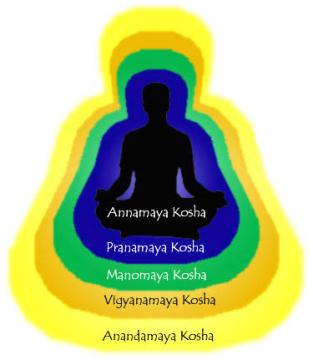
In my personal practice and my teaching, I find the concept of the five aspects of ourselves – the pancha koshas – a vital foundation to help me create practice plans addressing all the aspects. Pancha is a Sanskrit word that simply means five, and kosha means sheath. All aspects are to be nourished and supported by different practices in the "yoga toolkit" (as my teacher Swami Pragyamurti calls it).
Another way of putting it is that we humans are like a lamp that has five lampshades over our light. Each of the lampshades is a different colour and density. As the light shines through the lampshades, it is progressively changed in colour and nature. On the one hand, the shades provide the individualized beauty of each lamp. Yet, the lampshades also obscure the pure light.
This mystical concept dates right back many thousands of years to the Taittiriya Upanishad. [The word Upanishad refers to teachings received "at the feet of the teacher".]
The Taittiriya speaks of five levels of functioning through which we can achieve self-realization:
- The anna-maya-atma or the "Self (atma) made of Food" (anna = food)
- The prana-maya-atma or "the Self made of Vital Breath (prana)
- The mana-maya-atma or "the Self made of Mind (manas)"
- the Vijnana-maya-atma or "the Self made of Consciousness or intellect (vijnana)"
- the Ananda-maya-atma or "the Self made of Bliss (ananda)", where one attains realization
Note that instead of the word kosha or sheath, the Upanishad speaks of atma or soul. Maya is sometimes said to mean "made of" [anna, prana etc) whereas it is also said by much later scholars - perhaps even 1500 years later - that maya means "illusion" or even "delusion", This brings a a focus on the problems that arise when we believe the illusion that we are only the body, or only the mind, confusing one part of us with the whole. Think about our modern preoccupation with our body shape, our physical health, or even “I think, therefore I am”. But we can make good use of these parts of us to make progress: for example the breath is closely connected to the mind and affects emotional states. So, too, can physical postures. Yoga works holistically on the level of our whole being. .
First layer or sheath – Annamaya kosha - the physical body - anna means food
We are born into the physical world, which is the outermost, solid layer. Our body awareness is the entry point to the process of moving towards spiritual enlightenment and for many people a great introduction is via the body-based practices of hatha yoga. But we can hold to the illusion that we are the body and that’s all we are. Perhaps we can develop towards regarding the body as temple of the soul, to be cherished and kept as healthy as possible by asanas, pranayama, shatkarmas (cleansing practices), a modest, balanced diet & fasting and the right amount of rest.
Second aspect – Pranamaya kosha – the energy level: the layer of our being connected with prana, life force. Some people also call it the aura. We are energy beings, constantly taking in and giving out energy. As we start to practice awareness of the physical body in the asanas, we begin to feel and become aware of breath, sensations and emotions. Pranamaya kosha is said to be the link between body and mind, and pranayama practices can help to restore balance to body and mind. And of course we can practice this at any time of the day, not just when doing asanas. Purified by asanas (+breath awareness), specific pranayama practices and mouna (silence).
Third aspect – Manomaya kosha – the reactive mind: manas = mind. Often described as the “lower” or instinctive and reactive mind, it is a crucial part of our functioning. Its job is to make sense of the world as we experience it via the five senses. Mind is supported and purified by asanas + breath awareness, pranayama, fasting, karma yoga, chanting and meditation.
Fourth aspect– Vignanamaya kosha (the gn is pronounced as in the Spanish word mañana). This layer, sometimes referred to as the intellectual sheath, has the functions of reflecting and applying wisdom and discrimination. Purified by karma yoga, meditation, positive thinking, and self study.
Fifth aspect – Anandamaya kosha or bliss. This innermost sheath expresses the idea that we are, in our innermost true Self, in a state of bliss at our still centre where we know all we need to know and can see things clearly. Unfortunately it doesn't last unless we are truly and permanently an enlightened being, but even a glimpse is deeply satisfying.
Perhaps this structure will help us include different practices in the life-support system known as Yoga, which is far, far more than asanas. You'll find more information in my most recent blog and I'm planning to link this newsletter with practice plans.

